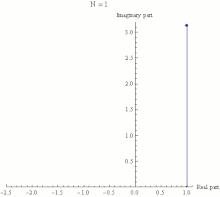The exponential function ez can be defined as the limit of (1 + z/N)N, as N approaches infinity, and thus eiπ is the limit of (1 + iπ/N)N. In this animation N takes various increasing values from 1 to 100. The computation of (1 + iπ/N)N is displayed as the combined effect of N repeated multiplications in the complex plane, with the final point being the actual value of (1 + iπ/N)N. It can be seen that as N gets larger (1 + iπ/N)N approaches a limit of −1.
In mathematics, Euler's identity[n 1] (also known as Euler's equation) is the equality
- e is Euler's number, the base of natural logarithms,
- i is the imaginary unit, which satisfies i2 = −1, and
- π is pi, the ratio of the circumference of a circle to its diameter.
Explanations
Analytic explanation
Euler's formula for a general angle
Euler's identity is a special case of Euler's formula from complex analysis, which states that for any real number x,
In particular, when x = π,
Geometric explanation
Consider any complex number z represented in polar coordinates:Mathematical beauty
Euler's identity is often cited as an example of deep mathematical beauty.[3] Three of the basic arithmetic operations occur exactly once each: addition, multiplication, and exponentiation. The identity also links five fundamental mathematical constants:[4]- The number 0.
- The number 1.
- The number π (π = 3.141...).
- The number e (e = 2.718...), which occurs widely in mathematical analysis.
- The number i, the imaginary unit of the complex numbers.
Stanford University mathematics professor Keith Devlin has said, "like a Shakespearean sonnet that captures the very essence of love, or a painting that brings out the beauty of the human form that is far more than just skin deep, Euler's equation reaches down into the very depths of existence".[5] And Paul Nahin, a professor emeritus at the University of New Hampshire, who has written a book dedicated to Euler's formula and its applications in Fourier analysis, describes Euler's identity as being "of exquisite beauty".[6]
The mathematics writer Constance Reid has opined that Euler's identity is "the most famous formula in all mathematics".[7] And Benjamin Peirce, a noted American 19th-century philosopher, mathematician, and professor at Harvard University, after proving Euler's identity during a lecture, stated that the identity "is absolutely paradoxical; we cannot understand it, and we don't know what it means, but we have proved it, and therefore we know it must be the truth".[8]
A poll of readers conducted by The Mathematical Intelligencer in 1990 named Euler's identity as the "most beautiful theorem in mathematics".[9] In another poll of readers that was conducted by Physics World in 2004, Euler's identity tied with Maxwell's equations (of electromagnetism) as the "greatest equation ever".[10]
A study of the brains of sixteen mathematicians found that the "emotional brain" (specifically, the medial orbitofrontal cortex, which lights up for beautiful music, poetry, pictures, etc.) lit up more consistently for Euler's identity than for any other formula.[11]
At least two books in popular mathematics have been published about Euler's identity. One is A Most Elegant Equation: Euler's formula and the beauty of mathematics, by David Stipp (2017). Another is Euler's Pioneering Equation: The most beautiful theorem in mathematics, by Robin Wilson (2018).
Generalizations
Euler's identity is also a special case of the more general identity that the nth roots of unity, for n > 1, add up to 0:In another field of mathematics, by using quaternion exponentiation, one can show that a similar identity also applies to quaternions. Let {i, j, k} be the basis elements, then,
History
It has been claimed that Euler's identity appears in his monumental work of mathematical analysis published in 1748, Introductio in analysin infinitorum.[12] However, it is questionable whether this particular concept can be attributed to Euler himself, as he may never have expressed it.[13] Moreover, while Euler did write in the Introductio about what we today call Euler's formula,[14] which relates e with cosine and sine terms in the field of complex numbers, the English mathematician Roger Cotes (who died in 1716, when Euler was only 9 years old) also knew of this formula and Euler may have acquired the knowledge through his Swiss compatriot Johann Bernoulli.[13]Robin Wilson states the following.[15]
We've seen how it [Euler's identity] can easily be deduced from results of Johann Bernoulli and Roger Cotes, but that neither of them seems to have done so. Even Euler does not seem to have written it down explicitly – and certainly it doesn't appear in any of his publications – though he must surely have realized that it follows immediately from his identity [i.e. Euler's formula], eix = cos x + i sin x. Moreover, it seems to be unknown who first stated the result explicitly….
















